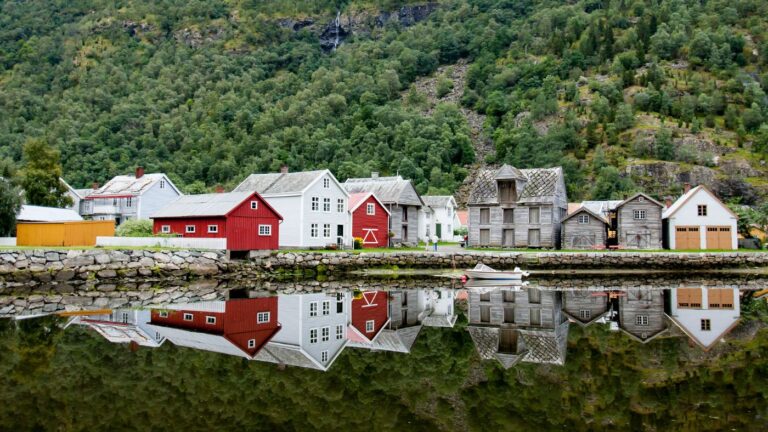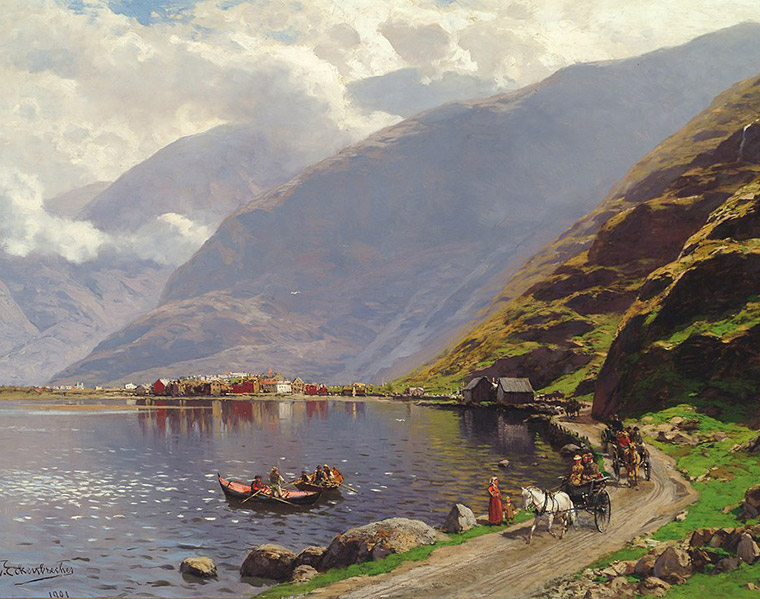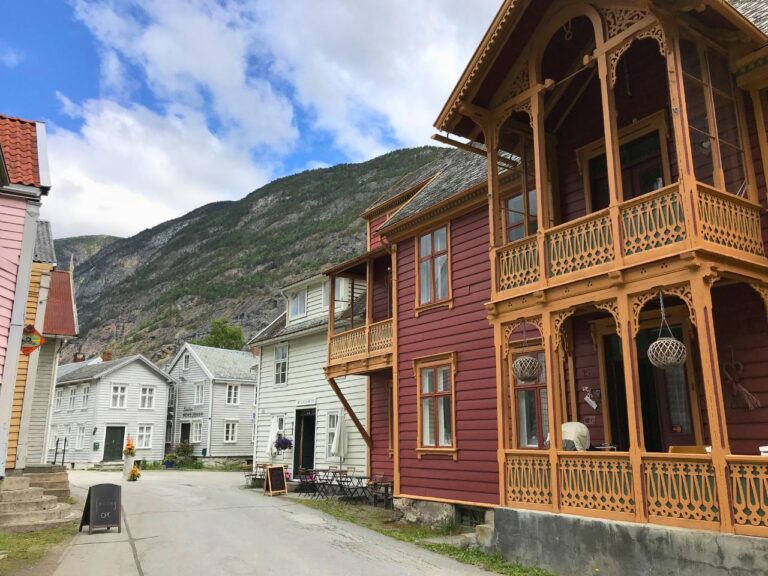A former trading port between east and west Norway, Lærdal today is a picture-perfect stop on the fjord Norway travel trail, blending dramatic scenery with a remarkably preserved historic village and one of Scandinavia’s architectural treasures.
Lærdal sits on the southern shore of the mighty Sognefjord, roughly midway between the fjord coast and the high mountains of eastern Norway.

Long before the arrival of modern roads and tunnels, this location gave the village a strategic importance that belies its modest size.
For centuries, the most reliable way to move goods between Norway’s two great regions (the coast and the eastlands) was not over the windswept mountain plateaus but up the fjord.
Traders sailed inland as far as possible, docking at Lærdalsøyri and continuing overland along ancient packhorse trails and, later, the King’s Road to Valdres and onwards to Oslo.
The landscape is dramatic, but it is also deeply practical. In many ways, Lærdal is where western Norway meets the interior, a place where Sognefjord culture and mountain culture overlap.
Table of Contents
The Old Village of Lærdalsøyri
Lærdalsøyri is the historic core of the municipality, a compact settlement of narrow lanes, traditional timber homes and former trading houses dating back to the eighteenth and nineteenth centuries.
In its heyday, this was a bustling river harbour and marketplace, where merchants, farmers and travellers exchanged grain, livestock, herring, salt, iron and timber.
Although a major fire in January 2014 tore through parts of the village, destroying dozens of buildings and forcing the evacuation of residents, most of the historic heart survived thanks to heroic efforts by locals and emergency services.

Restoration work continues to this day, and walking through the streets reveals a community proud of its past and determined to protect it.
With approximately 1,000 residents in the village and roughly the same again in surrounding settlements, Lærdal retains a peaceful, lived-in feel. There is no sense of a staged museum here. This is a village with real families, real life and a river that still matters.
Exploring the Heritage Village
Much of the charm lies in wandering slowly. Timber homes lean gently towards cobbled streets. Brightly painted façades contrast with weather-beaten doors and window frames.
Signage explains the history of important trading houses and inns. From time to time, a gentle breeze brings the scent of the nearby fjord or the river, a reminder of the forces that shaped this place.
The tourism office at Øyraplassen is a helpful first stop if you have limited time. Staff provide walking maps, advice on scenic drives and practical tips for visiting local attractions.
During summer, you will also find pop-up galleries, craft studios and farm-stand stalls offering honey, jams and local produce.
Places to Stay in Lærdal
Lærdal does not offer large chain hotels, which only adds to its charm for visitors seeking a slower, more intimate fjord experience.
In the heart of the old village, accommodation at the Lærdalsøren Hotel offers characterful rooms surrounded by history.

At the water’s edge, Lærdal Holiday & Leisure Park provides cabins, camping, apartments and motel-style rooms with views of the river delta and mountains.
Staying overnight allows time to enjoy the quiet evening atmosphere when the day-trippers have moved on. As the light softens across the valley, the river glimmers and the old houses seem to exhale under the shade of steep mountainsides.
The Lærdal Fire of 2014
The night of 18–19 January 2014 remains etched into local memory. A fire that began in a private residence on Kyrkjegata spread rapidly due to strong winter winds.
Within hours, emergency teams from across western Norway had arrived, joined by helicopters and military support. Around 30 buildings burned, yet the scale of destruction could have been far worse.
Quick action, natural breaks between structures and a dose of luck spared the majority of the preserved village.
Today, the fire serves as a sombre reminder of the vulnerability of wooden towns in Norway. It also stands as a testament to resilience: restoration and conservation have strengthened the commitment to safeguard Lærdalsøyri’s cultural heritage for future generations.
The Snow Road to Aurland
Most travellers arrive in Lærdal via the E16, but those visiting in summer may choose a more spectacular approach.
The National Scenic Route Aurlandsfjellet, often called the Snow Road, crosses a desolate mountain plateau where walls of snow linger well into the warmer months.
The journey provides a powerful contrast: lush fjord scenery gives way to near-barren rock and snowfields, then descends once more into fertile valley.

The road is typically open from late spring to early autumn. Even when it is closed, the iconic Stegastein viewpoint above Aurland remains accessible year-round, offering remarkable views down to the fjord in every season.
The Lærdal Tunnel
Drivers approaching from the west have another signature experience: the 24.5-kilometre Lærdal Tunnel, the world’s longest road tunnel.
Built between 1995 and 2000, it was designed not only to connect communities more efficiently but to protect motorists from fatigue.
Large caverns with gentle blue and golden lighting break up the journey, creating the sensation of daylight returning briefly before the darkness resumes.
An advanced ventilation system maintains air quality, and regular monitoring ensures the tunnel remains safe despite its immense length.
For many travellers, the tunnel becomes a curiosity in its own right. It's a modern engineering answer to Norway’s eternal challenge of mountains and weather.
Borgund Stave Church
Just east of Lærdal lies one of Norway’s greatest cultural treasures. Borgund stave church, completed around 1180, stands on a gentle rise surrounded by forest and meadows.
With its dragon-head carvings, tiered shingle roofs and intricate timber frame, the church feels like something from another world.
Norse decorative motifs blend with Christian iconography, reflecting a society still negotiating its religious identity. Inside, runic inscriptions hint at the lives of parishioners long gone.

Outside, the raised stone foundation reveals an impressive understanding of local conditions; without such foresight, the timber would never have survived eight centuries of Norwegian winters.
The visitor centre, built in a contemporary architectural style that complements the surroundings, offers exhibits on medieval building techniques, archaeology and the stave church tradition.
Beyond the Village: Nature and Rural Traditions
Although history draws many visitors, Lærdal is also a place of nature and agriculture. The valley, warmed by a local microclimate, has long been associated with fruit cultivation.
Local farms produce cherries, raspberries and strawberries, and roadside stands in summer are a delight for those travelling between the fjord and the mountains.
The Lærdalselvi river, once legendary for salmon, is gradually recovering following disease and parasite challenges. Conservation efforts continue, and anglers will still find stretches popular for fly-fishing during the permitted season.
For walkers, the restored King’s Road from Lærdal to Valdres is a highlight. This historic route includes stone bridges, cobbled ramps and traditional waymarkers. It may once have carried traders and royal messengers but today, it offers peace, scenery and a remarkable sense of stepping into the past.
Planning Your Visit to Lærdal
Lærdal is an ideal stop on a road trip through the Sognefjord region or en route between Bergen and Oslo. Public transport links exist via regional buses, though travel is most flexible by car.
The village is charming at any time of year, yet spring and summer offer livelier streets, open cafés and easier access to the mountain pass. Autumn brings golden colours along the riverbank, while winter provides a quiet, atmospheric retreat.
A single day allows for a stroll through the historic streets, a visit to Borgund stave church and a scenic drive.

